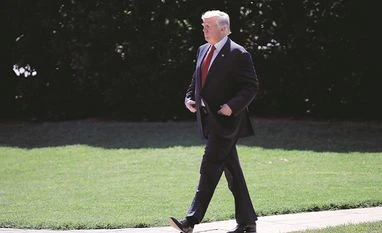For decades North Korea threatened American “imperialists” and our South Korean allies with a “sea of fire” and retribution for trying to contain their conventional and nuclear weapons projects. North Korean leaders have made as much noise as a small yappy dog confronting a placidly tolerant Rottweiler trying to take away its nuclear bone.
President Trump, seemingly oblivious to America’s dominant military, economic and political status, has borrowed from North Korean state media scripts by bombastically threatening Pyongyang on Tuesday with “fire and fury” and an unspecified assault “the likes of which this world has never seen before.” Since the world has witnessed the horror of atomic bombs used by the United States on Japan at the end of World War II — weapons much smaller than the nuclear weapons being built by North Korea — these words are alarming.
Unfortunately, we can’t simply dismiss the president’s words out of hand. He is on the record in a 1999 NBC interview noting that “the biggest problem this world has is nuclear proliferation,” but then appearing to entertain a pre-emptive military strike against North Korea before they have “warheads, every one of them pointing to New York City, to Washington.” He dismissed an observation by his interviewer, Tim Russert, that military commanders have warned against such pre-emptive military action.
The president’s cabinet therefore needs to emphasize the human cost of trying to eliminate North Korea’s plutonium- and uranium-based nuclear facilities and weapons. The costs would be staggering — possibly millions of South Korean and thousands of American lives. And because we presumably don’t know where all the nuclear facilities, material, scientists and weapons are hidden, and because North Korea has mobile ground launchers, a major military strike might not even succeed.
The only solution is a multipronged strategy aimed at containing the threat posed by North Korea. The North Korean leader, Kim Jong-un, came to power at the end of 2011 with three main objectives: consolidate his power, prevent international actors from overthrowing his regime and carrying out gradual economic reform so the Kim dynasty could retain power over the long run.
This last point is often overlooked. Young Kim was educated in Switzerland, and long-time Korea analysts say he understands he cannot keep North Koreans economically oppressed and ignorant of their impoverished status relative to the rest of the world forever. But he will need time to strengthen the nation’s economy.
North Korea’s newly demonstrated ability to launch a missile that could reach the United States mainland is intended to deter Washington from intervening politically or militarily. Most experts believe that the Kim family will use nuclear weapons against the United States only if it believes an attack is imminent.
Therefore, the best policy would be to simultaneously employ deterrence, pressure, diplomacy and incentives — and learn from past successes and failures. We must continue to bolster our missile defenses, conduct military exercises with South Korean and Japanese allies and underscore the viability of the United States nuclear umbrella. Pressure will come from robust enforcement and continued tightening, if necessary, of the new United Nations sanctions.
Diplomacy will be required to explain to the North Koreans — as well as to the Chinese and Russian governments, which are nearly as opposed to regime change as Pyongyang is — that our aim is not to kick out Mr. Kim or eliminate the North Korean state, but to address the threat posed by its nuclear weapons. Working with China, Washington can offer incentives to encourage North Korea to continue its first steps toward market reform and privatization.
As for learning from our mistakes, I observed from Capitol Hill and in a 2008 visit to Pyongyang and Yongbyon, one of the North’s major nuclear facilities, that the Agreed Framework signed in 1994 worked until the North Koreans cheated and Washington failed to keep them at the table with diplomacy, pressure and incentives. And sanctions worked in the early 2000s, until we rescinded them without a conclusive deal.
Finally, the United States can build trust and make progress on what North Korea calls “humanitarian” issues: winning release of American and Japanese hostages held by Pyongyang; allowing reunions between North and South Korean families and repatriating the remains of American troops from the Korean War.
President Trump has a chance now to simultaneously apply all four prongs of a strategy — deterrence, pressure, diplomacy and incentives — to not only contain the threat from North Korea, but also pave the way for economic reform and real change for the North Korean people. That is something only a superpower, working with it allies and even adversaries and competitors like Russia and China, can do. Let’s swap brimstone for bargaining.
© 2017 New York Times News Service
Unlock 30+ premium stories daily hand-picked by our editors, across devices on browser and app.
Pick your 5 favourite companies, get a daily email with all news updates on them.
Full access to our intuitive epaper - clip, save, share articles from any device; newspaper archives from 2006.
Preferential invites to Business Standard events.
Curated newsletters on markets, personal finance, policy & politics, start-ups, technology, and more.
)